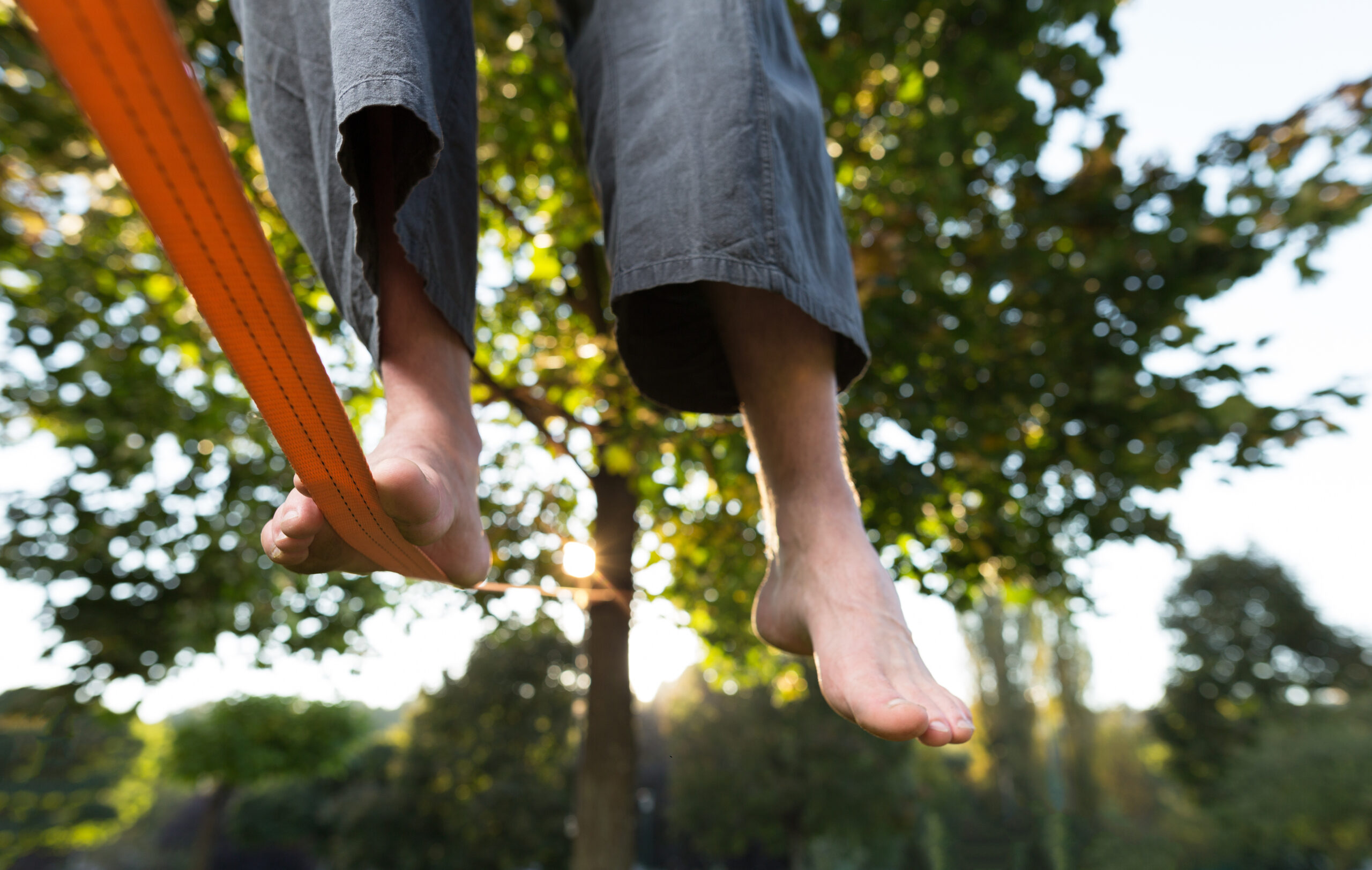The common size of slacklines are 1″ and 2″ in width. While you can choose either size and may even find other less common widths available, you do tend to find that experienced slackliners choose 1″ wide slacklines whereas beginner slacklining kits usually come with the wider 2″ line.
A 1″ wide slackline offers half the landing width that a 2″ line does and tends to be less stiff and more elastic than the wider 2″ line. 2″ wide slacklines tend to be better for tricklining and urbanlining whereas a 1″ line is suitable for regular slacklining, highlining and waterlining.
Some manufacturers also offer less common slackline widths including 5/8″, 35mm (1.37″) and other sizes that you may occasionally come across. For the most part though you’ll see the 1″ (2.5 cm) and 2″ (5 cm) widths widely available.
Which should you choose and why? Let’s take a closer look at 1″ and 2″ wide slacklines, why you may choose either option and what you should expect from each.
1″ slackline
What characteristics does a 1 inch wide slackline have?
The obvious answer is that a 1″ slackline is half the width of a 2″ line but what implications does this have on your slacklining?
Many experienced slackliners go for the basic 1 inch wide slackline once they become comfortable. Some simply find it easier to walk on.
The thinner 1″ line tends to flex and move less than the thicker 2″ line. This means the 1″ wide lines have less upward force and tend to require you to stabilize yourself less. The wider 2″ lines are better for tricklining that requires some bounce to the line.
So if you’re just looking for a line to walk on, less bounce is better, hence the choice of a 1″ line for many slackliners. This includes longlining and waterlining which can also utilize 1″ lines successfully.
2″ slackline
What characteristics does a 2 inch wide slackline have?
The obvious answer is that a 2″ slackline is double the width of a 1″ line but what implications does this have on your slacklining?
A 2″ wide slackline is a great choice for a new slackliner and for those who take part in highlining or tricklining. 2 inch wide slacklines utilize a ratchet system to help you tension the slackline to the necessary degree. A ratchet enables you to quickly and expertly tighten the slackline as required.
You often find that beginner slacklining kits come with a 2″ main slackline and perhaps a 1″ training line. A training line or top line is one that is set up over top of the main slackline that you stand on. You can hold onto the training line above your head to help keep your balance as you learn slacklining and figure out how to keep your balance.
A 2 inch wide slackline offers a wider landing area and will tend to be a better option for beginners who might like the extra width between their feet as they learn slacklining.
1 inch vs 2 inch slackline comparison table
| 1″ slackline characteristics | 2″ slackline characteristics | |
| Width | 1″ wide webbing so the landing area is half the size of a 2″ slackline. | 2″ wide webbing so the landing area is double the size of a 1″ slackline. |
| Feel | Given that it’s half the size of a 2″ line, a 1″ line will feel much smaller on your feet i.e. like you’re standing on string. | Given that it’s double the size of a 1″ line, a 2″ line will feel much larger on your feet i.e. like you’re standing on a board. |
| Stretch | Less stiff and more elastic than a 2″ line given that a 1″ line is half the material wide. | Stiffer and less stretch than a 1″ line since a 2″ line is double the material wide. |
| Sway | Will tend to sway (shake) a little bit less than a 2″ line. | Will tend to sway (shake) a little bit more than a 1″ line. |
| Best use | A 1″ line is great for experienced slackliners and for regular slacklining. Often used for longlining and waterlining. | A 2″ line is great for both newbies and experienced slackliners. A 2″ line tends to be better for tricklining given its superior upward force and relative stiffness to a thinner 1″ line. |
Summary
Should you choose a 1″ or 2″ wide slackline? The good news is that you can try both, see if you prefer one over the other and make your decision. Or you could use both and mix up the challenge.
You may also find that you need to play around with 1″ and 2″ lines with shoes and barefoot and see if you notice a difference there, too.
While a 2″ slackline is often included as part of beginner kits and is also the preferred choice for many trickliners and highliners, you can pick a 1″ or 2″ wide slackline as you feel fit for regular slacklining.
1″ lines are suitable for experienced slackliners and those who take part in waterlining or longlining, too.
When you’re starting out, look for a slackline webbing that is low stretch. This means you can set the slackline up closer to the ground and not worry about the line touching the ground when you step on it. The less the line stretches, the lower to the ground you can set it up for safety reasons as you’re learning.
Recent Posts
Slacklining is a challenging activity that involves walking, balancing, and performing tricks on a flat piece of webbing stretched between two anchor points. It has become increasingly popular in...
Slacklining is a fun and challenging way to improve your balance, core strength, and overall fitness. Whether you're new to slacklining or a seasoned pro, incorporating a slackline workout routine...


